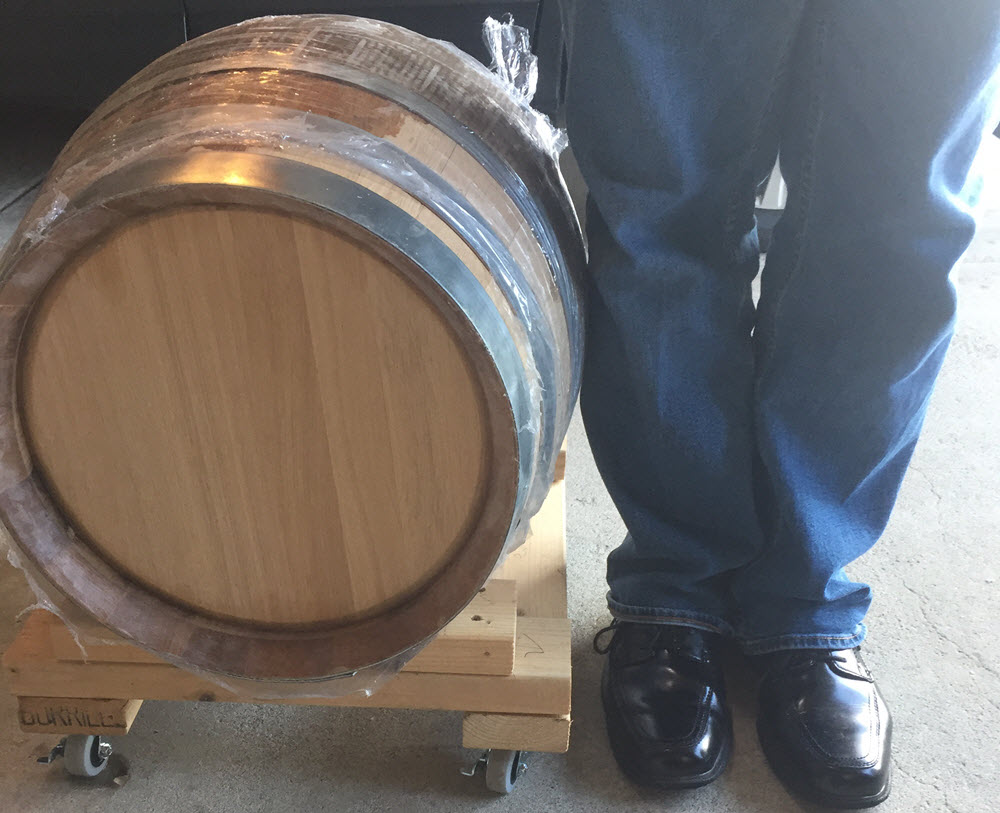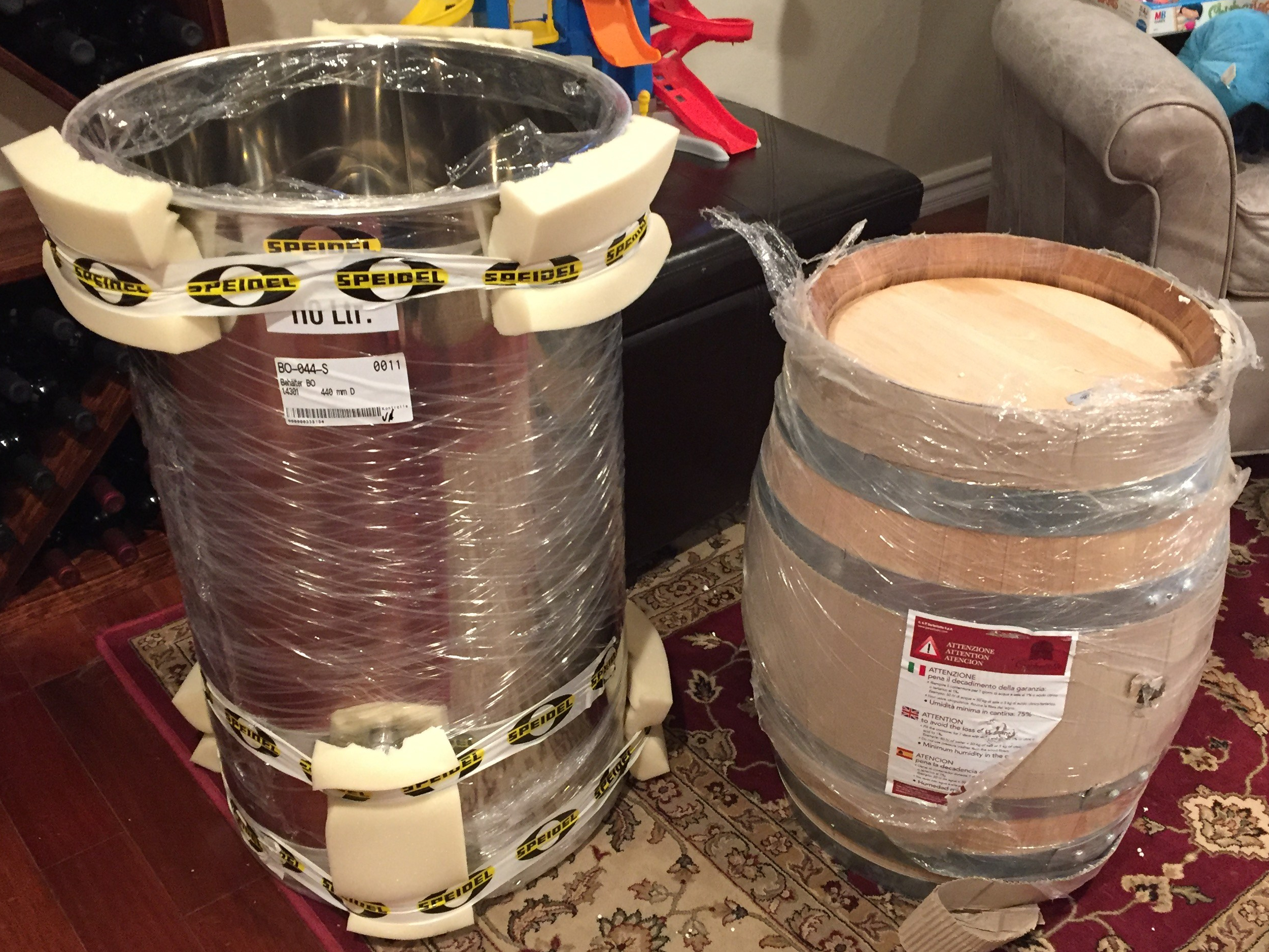 After making wine for 7 years using carboys, and always aiming for a little bit richer, a little more complicated red, we knew we had to up our game. At the Wine Maker Magazine annual conference last year, I attended a session discussing of the benefits of aging wine in barrels. It turns out that tannins in wine – particularly red wine – interact with oak to generate structure and body, not just an oaky taste. Of course there’s much more to it than that.
After making wine for 7 years using carboys, and always aiming for a little bit richer, a little more complicated red, we knew we had to up our game. At the Wine Maker Magazine annual conference last year, I attended a session discussing of the benefits of aging wine in barrels. It turns out that tannins in wine – particularly red wine – interact with oak to generate structure and body, not just an oaky taste. Of course there’s much more to it than that.
Even though all our wine making has used carboys, this conference inspired my thinking. Could we use a barrel in our wine making? Although we thought we could make better wine, we were daunted. We knew it would cost more but didn’t know much else. I started doing some research so I could get Susan a barrel for Christmas. It turned out we needed a more than just a barrel!
I asked staff at our local winemaking store.
-
The idea of containers suddenly becomes more complicated
There’s bewildering array of barrels for sale. The most common size for home winemaking is 30 gallons, but you can get barrels in other sizes ranging from 1 gallon to 30,000 liters. They can be made from various materials including French, American and Hungarian Oak. It might be made from French oak, but made in Italy. You can choose to buy new or used. You can get a carboy for less than $30 but barrels start in the hundreds. Knowing Susan likes the subtleness of French oak-aged chardonnay, I bought a new 13-gallon barrel made of French Oak from The Vintner Vault in Paso Robles, California.
-
You’ll spend time caring for your barrel – much more than for a carboy
It turns out you can’t just clean, dry and re-use barrels. When you first put liquid in them the wood swells. If you then allow them to dry out, the wood contracts and can split, ruining them. So you need to keep them full of wine or a storage solution (typically water containing citric acid and potassium metabisulfite). That means sequencing a series of wines one after the other or using a storage solution in-between batches.
As always with winemaking, you must clean your vessel after using it. Think about that for a moment. It’s easy to clean a carboy that weighs about 45-50 lbs, but barrels can weigh 30 pounds even with no liquid! The only opening is an inch-sized hole, so it’s pretty hard to see what you’re cleaning on the inside. What if the barrel needs to be moved? You’re not going to move it if it’s got 13 gallons of liquid in it.
Before we could use our barrel, we spent an afternoon designing and assembling a barrel dolly. Using rolling casters and 2x4s cut to cradle the barrel, we were able to create a serviceable dolly that has helped to move the full barrel around our flat, concrete garage floor.

-
You’ll need more than just a barrel
Particularly early in a barrel’s life, wine needs to be removed promptly to prevent over-oaking. I didn’t want wine that tastes like wood juice (too much oak and we couldn’t make the delicate French Chardonnay Susan enjoys). To remove it on time, the wine needs to come out of barrel and be stored somewhere else before it gets bottled. I realized I needed a variable-volume fermenter larger than the barrel, too.
Knowing wine disappears gradually through a barrel via evaporation, we needed to protect the wine from the air gap evaporation leaves. Since we didn’t want our wine to oxidize, as headspace develops the barrel needs to be topped up. So I bought a 5-gallon keg to supply top-up wine. Of course the top-up wine can’t be allowed to oxidize either, so I needed a tank of inert gas to expel oxygen from the keg. I chose argon, but in addition I needed the hoses and connectors to supply it to the keg. The list was growing.
Finally, you can transfer all this wine from one place to another using your trusty siphon but that might take a while. As valuable as it is, a trusty siphon will not work to move wine from a barrel that rests on the floor to a tank that is on a table. A better solution is a transfer pump.
The full list:
- 13.9 gallon barrel
- Variable volume fermenter (110 liters)
- 5 gallon keg with hoses, hose clamps and connectors
- Argon cannister and regulator
- Transfer pump and filter (to protect the motor from particulate matter)
- A barrel dolly
So here we are. We ended up with a lot of paraphernalia to connect everything together. It’s not just a barrel.
-
You’ll make better wine
We’re still in the process with our first few barrel batches. We used it first to ferment some Chardonnay, then some Vigonier in the barrel. Now we’ve moved to reds so we pumped in the 2017 Petite Sirah we had aging in carboys. Although we’re not finished with any of them we’ve tasted each and we’re encouraged. It’s tasting good! I now know first hand that there are good reasons to use barrels to develop better tasting wines.
Turns out, if you have a wine making wife like mine, a barrel makes a really good Christmas gift. Just don’t do it without realizing what you’re committing to!

Leave a Reply